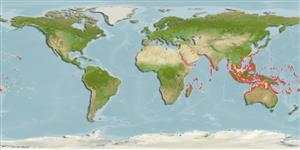Common names from other countries
分类 / Names
俗名 | 同种异名 | Catalog of Fishes(属, 种) | ITIS | CoL | WoRMS | Cloffa
Teleostei >
Atheriniformes (Silversides)
銀漢魚目 (Silversides) >
Atherinidae (Silversides)
銀漢魚科 (Silversides) > Atherinomorinae
Etymology: Atherinomorus: Greek, atherina, the Greek name for the eperlane + Greek, moros = silly, stupid (Ref. 45335).
More on author: Forster.
Environment: milieu / climate zone / depth range / distribution range
生态学
海洋; 淡水; 半咸淡水 礁区鱼类; 深度上下限 1 - 39 m (Ref. 11897). 亞熱帶的; 32°N - 23°S, 32°E - 154°W
Indo-Pacific: from East Africa to Tonga, north to southern Japan, and south to northern
Australia; except Andaman Sea. Replaced by Atherinomorus insularum in the Hawaiian Islands (Ref. 37816).
印度-太平洋: 紅海而且東非到夏威夷, 薩摩亞人與鳳凰島, 北至日本南部與小笠原群島, 南至澳洲的昆士蘭省與新加勒多尼亞。 最近迴游進入地中海東部之內了經過蘇伊士運河。 被 Atherinomorus insularum 取代了在夏威夷群島。 (參考文獻 37816)
大小 / 重量 / 年龄
Maturity: Lm ? range ? - ? cm
Max length : 25.0 cm TL 雄鱼/尚未辨别雌雄; (Ref. 48635)
背棘 (总数) : 5 - 8; 背的软条 (总数) : 9 - 10; 臀棘: 1; 臀鳍软条: 12 - 17; 脊椎骨: 43 - 44. This species is distinguished by the following characters: lateral process of premaxilla very low and wide; upper margin of the dentary almost flat distally, no distinct tubercle at the posterior end; posterior tip of the upper jaw reaching to or beyond a vertical through anterior margin of the pupil, sometimes reaching to the center of pupil; small teeth on endopterygoids, not forming obvious ridges; the anus is near or usually behind the posterior tip of the pelvic fin; lower gill rakers 18-24; midlateral scale count 40-44; lower margin of midlateral band reaching below ventral end of the midlateral (third) scale row and reaching to almost the center of the fourth scale row at level of the anal fin origin (Ref. 58474).
正在向后地延伸的上颌的末端到垂直的经过前缘瞳孔; 齿骨的分离边缘几乎平坦, 没有在后部的海拔; 在侧面中央的系列 39-44 中的鳞片.(参考文献 9760) 前颌骨的分支长的, 延伸经过垂直的经过瞳孔的前缘。 肛门在或在腹的顶端之前。 四个像凹洞一样的孔在头部背面上, 通常被大的鳞片覆盖。 腋窝的鳞片大的但是通常脱落。 身体绿色的,淡黄色的或褐色的。 身体的上半部总是比较黑的。 大多数的鳞片有黑色边缘了。 (也见参考文献 559).
Common in large schools along sandy shorelines and reef margins. Reported to be mainly a nocturnal species which usually forms schools (from several hundred to more than 100 m long and 20 m wide) (Ref. 9760). Feeds mostly at night when the school disperse. Feeds on a variety of planktonic crustaceans. Preyed upon by sharks, tunas, long toms, and amberjacks which swim alongside the school. Among its other predators are crested terns, gannets, sea-gulls and herons. Slow moving and not well regarded as bait. Extremely important as forage fish for larger species (Ref. 3302). Sold fresh, or salted and dried (Ref. 12484). Minimum depth reported taken from Ref. 57178.
常见一大群沿着沙质海岸线与礁区边缘。 缓慢移动的而不是视为良好的诱饵。 吃浮游动物,小型底栖性无脊椎动物。 (参考文献 5980) 为大型鱼种的非常重要的饵料鱼.(参考文献 3302) 以生鲜或盐渍和乾制贩卖.(参考文献 12484)
Life cycle and mating behavior
Maturities | 繁殖 | Spawnings | Egg(s) | Fecundities | 仔鱼
印度-太平洋: 紅海而且東非到夏威夷, 薩摩亞人與鳳凰島, 北至日本南部與小笠原群島, 南至澳洲的昆士蘭省與新加勒多尼亞。 最近迴游進入地中海東部之內了經過蘇伊士運河。 被 Atherinomorus insularum 取代了在夏威夷群島。 (參考文獻 37816)
Kimura, S., D. Golani, Y. Iwatsuki, M. Tabuchi and T. Yoshino, 2007. Redescriptions of the Indo-Pacific atherinid fishes Atherinomorus forskalii, Atherinomorus lacunosus, and Atherinomorus pinguis. Ichthyol. Res. 54(2):145-159. (Ref. 58474)
CITES (Ref. 128078)
Not Evaluated
人类利用
渔业: 商业性; 诱饵: usually
工具
特别资料
下载 XML
网络资源
Estimates based on models
Preferred temperature (Ref.
115969): 24.9 - 29.1, mean 28 (based on 1080 cells).
Phylogenetic diversity index (Ref.
82804): PD
50 = 0.5005 [Uniqueness, from 0.5 = low to 2.0 = high].
Bayesian length-weight: a=0.00759 (0.00428 - 0.01346), b=3.16 (3.00 - 3.32), in cm Total Length, based on LWR estimates for this species & (Sub)family-body (Ref.
93245).
营养阶层 (Ref.
69278): 3.3 ±0.2 se; based on diet studies.
回复力 (Ref.
120179): 中等的, 族群倍增时间最少 1.4 - 4.4年 (Preliminary K or Fecundity.).
Fishing Vulnerability (Ref.
59153): Low vulnerability (15 of 100).
